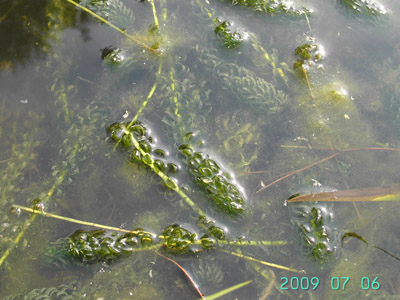Lagarosiphon major (Ridley) Moss (syn.: L. muscoides Harvey var. major Ridley) (S-Afr.) – An increasing, locally naturalised alien in fishponds and canals. Apparently first recorded in 1993 in Lives-sur-Meuse in an old branch of river Meuse but soon gone after its discovery (Bouxin & Lambinon 1996). Subsequently found in abundance in a small canal in the city of Ieper in 2004, later also near Stene, Vosselaar, Nieuwpoort, Herselt and doubtlessly elsewhere (important populations, for instance, in artificial water bodies alongside E403 motorway in Gullegem-Moorsele in 2013). The recent locations, all in Flanders, are stable and Lagarosiphon major appears to be well naturalised by now. Additional information on its incipient invasion in Belgium and elsewhere in western Europe is available at: http://ias.biodiversity.be/species/show/68 and http://www.q-bank.eu/Plants/Factsheets/Lagarosiphon%20major%20NL.pdf.
The species is sometimes rather reminiscent of Elodea nuttallii and is possibly still confused with it. Both often share the strongly recurved leaves but Lagarosiphon is usually a more robust species with leaves commonly wider and longer and obviously spirally arranged in the lower parts and very densely crowded in the upper part of the stems. A better understanding of Lagarosiphon major in Belgium would possibly yield many additional records.


Selected literature:
Bouxin G. & Lambinon J. (1996) Deux xénophytes aquatiques nouveaux pour la Belgique, Myriophyllum heterophyllum et Lagarosiphon major, dans la Meuse à Lives-sur-Meuse (province de Namur). Nat. Mosana 49 : 94-97.
Hussner A. (2006) Die aquatischen Neophyten in Nordrhein-Westfalen. Decheniana 159: 39-50.
Van Valkenburg J. & Pot R. (2008) Lagarosiphon major (Ridl.) Moss (Verspreidbladige waterpest) nu ook bevestigd in de Groene Ruimte in Nederland. Gorteria 33: 89-92.

